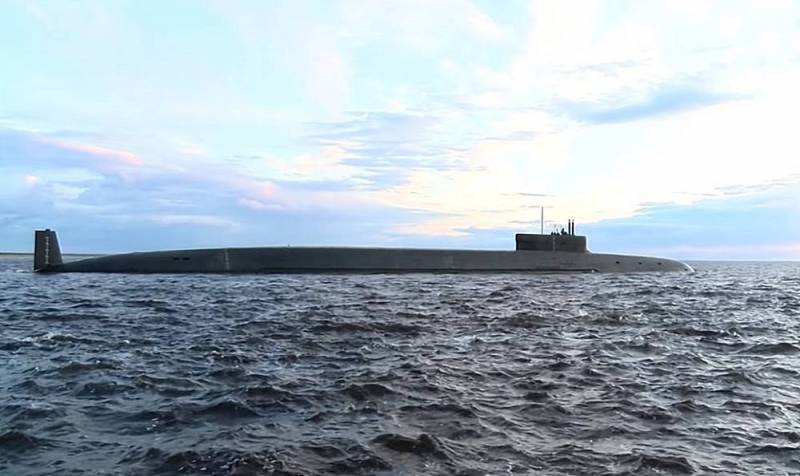US Navy "clogs" passages to the Atlantic for Russian nuclear submarines
Due to the weakness of the surface component of the fleet, nuclear submarines are one of the most important components of the Russian “nuclear triad”. The invisible game of "cat and mouse" between submarines and anti-submarine forces has been going on continuously since the days of the Cold War. But what will happen if the United States and NATO get a full advantage over our submariners?
Perhaps the main fear of the Pentagon is the risk of a repetition of the operation of the Soviet Navy, called "Atrina". In 1987, five Soviet nuclear submarines of the Northern Fleet secretly crossed the Atlantic Ocean and approached the east coast of the United States at a missile strike range. Then they safely returned back to the base. For Americans, confident in their impunity, this was a real shock. According to their military doctrine, our submarines must be under constant surveillance in order to be able to destroy them immediately in the event of a war. The success of "Atrina" had a huge political significance for Moscow.
After the collapse of the USSR, the combat capabilities of our surface and submarine fleets were sharply reduced. The United States relaxed so much that it disbanded its Second Fleet, designed to keep the North Atlantic under its control. But after the events of 2014 in Ukraine, which led to the beginning of the degradation of relations between Russia and the West, Washington could no longer consider itself completely safe. American Admiral James Foggo commented on this as follows:
For the first time in a long time, we are witnessing a significant increase in the submarine activity of the Russian Navy. Russia continued to invest resources in developing its capabilities in the underwater environment. It's an asymmetric way to challenge the West and NATO, and Russia is doing well.
The main threat to the United States, in addition to strategic missile submarines, he named multipurpose nuclear submarines carrying Kalibr cruise missiles and Russian low-noise diesel-electric submarines. Upgraded "Caliber" with an increased flight range will be able to hit targets not only in Europe, but also military infrastructure on the American coast. All this prompted the Pentagon to take a series of retaliatory actions.
So, in 2018, the US Second Fleet was revived, and a special unit called the US Navy Submarine Offensive Force was created from among the most experienced military and civilian experts. Last year, the Black Widow 2020 anti-submarine exercise was held in the Atlantic, which involved two multipurpose nuclear submarines, two destroyers, the USS Wasp UDC and the Boeing P-8 Poseidon anti-submarine patrol aircraft. Whom they trained there to catch and destroy, it is clear. A squadron of American Poseidons and four Lancer strategic bombers are stationed in Norway, apparently targeting the Russian Northern Fleet. The Pentagon also dispatched its USS Seawolf-class low-noise assault submarine, one of the best in the world, to the Kingdom. NATO ships and aircraft in the Norwegian Sea are working on a joint search for Russian (and whose else?) Submarines.
Similar spearfishing is being conducted in the Mediterranean. A large-scale NATO military exercise called Dynamic Manta just recently ended. They involved simultaneously American, German, French, Italian, Spanish, Belgian and Turkish ships, submarines and anti-submarine aircraft. The formal host of the event was Italy, which provided its military bases on the island of Sicily for the Allies. Simultaneously with the US Sixth Fleet, the Second Fleet conducted anti-submarine exercises in the Atlantic Ocean.
It is obvious that the new administration in the White House intends to rally the North Atlantic Alliance as much as possible against the "Russian threat." The Americans insist that "Caliber" can hit all European capitals without decoding why Moscow might need it. But it works. Even Italy, conditionally friendly to Russia, has increased its military spending, moving from 13th to 12th place in the world in this ranking. At the same time, the Pentagon is building a powerful anti-submarine shield in order to minimize the risks from the nuclear submarines of the Russian Navy as much as possible.
And, alas, he is gradually getting it. The chances for Russian nuclear submarines to sneak past NATO into the Atlantic and head for the US coast are steadily diminishing. It will soon become extremely problematic to "leave" only at the expense of the underwater component. A strong surface fleet is needed, which will help ensure the safe exit of SSBNs to the combat patrol area, carrying out anti-submarine and anti-aircraft protection.
And here we are again forced to return to the controversial topic of domestic aircraft carriers. A lot of quite fair criticism has been said about our only remaining TARK "Admiral Kuznetsov". But it must be borne in mind that in the Soviet period, the tasks of the aircraft-carrying ships under construction were seriously different from the huge nuclear-powered aircraft carriers of the US Navy. Among them, we primarily included: ensuring the security of strategic nuclear submarines in the area of combat patrol, anti-submarine and air defense, as well as the fight against enemy surface forces. For this, "Admiral Kuznetsov" and his brothers on the project were equipped with anti-submarine helicopters and carrier-based aircraft.
Does Russia need aircraft carriers today? Yes, but not huge and expensive ones, like "Storm", which we simply have nowhere and nothing to build and then maintain, but lighter and more budgetary aircraft-carrying ships with missile destroyers and frigates for effective protection. They will not have to compete one-on-one with the Nimitz, their task is to safely bring the “strategists” to the area of the nuclear submarine deployment to deliver a nuclear missile strike against the United States and its allies.

Information